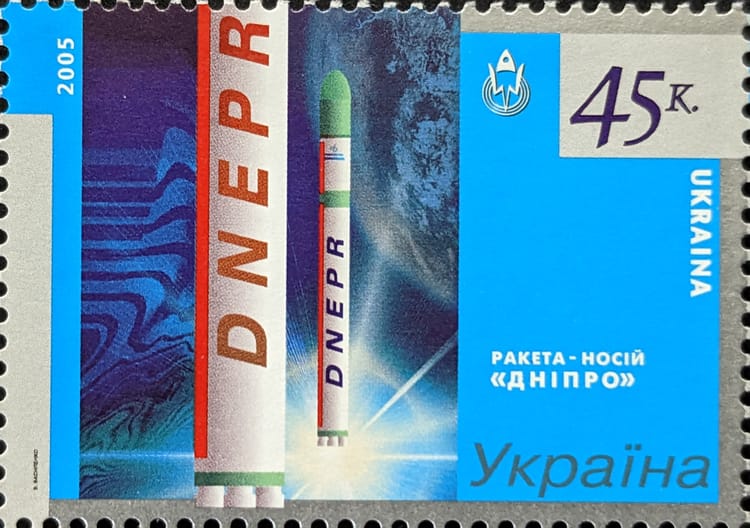Another Small Step for Amazon

Hard to believe it’s been over two weeks. We’ve finally reached a point in moving into our rental where I can sit comfortably on the sofa and write up another analysis. But it will be nice when Amazon delivers my desk--theoretically tomorrow.
Also, you might have noticed the stamp above. During our move, I found two books full of stamps I had collected when I was much, much younger. Why not share them?
Last week, a company associated with “new space” activities announced new and expanded space services. Oddly, and unlike many of its peers, it didn’t announce a need to raise funding. The services advertised exist. And, the company appears to be making money from existing space services.
The announcement came from Amazon Web Services (AWS) and posted on Amazon’s “Day One” blog site. The new business segment running these new services will be Aerospace and Satellite Solutions (ASS?AaSS?). The segment is supposed to:
- Reimagine space system architectures.
- Transform space enterprises.
- Launch new services that process space data on Earth and in orbit.
- Provide secure, flexible, scalable, and cost-efficient cloud solutions to support government missions and companies advancing space around the world.
A Thorough Grounding
Before getting into what those bullet points may indicate, remember that Amazon already took tentative steps into the ground part of the space communications infrastructure business when it announced AWS Ground Station in late 2018, working with Lockheed Martin’s new Verge antennas/ground system.
At the time, while AWS Ground Station was talked up by established space operators like Maxar/DigitalGlobe, the focus seemed to be on smaller/newer companies. From an interview with AWS Ground Station’s Shayn Hawthorne:
“Amazon’s vision is to democratize access to satellites and the enormous amounts of increasingly important data they’re collecting. Substantial investments are required to build the ground stations needed to uplink and downlink satellite data. With AWS Ground Station, customers that have not traditionally had the financial resources to build and operate their own satellite infrastructure will be able to access satellite services on-demand.”
Customers without financial resources sound like the “new space”-type companies, as well as university-run and small civil-run satellite operations. While DigitalGlobe is mainstream in the space industry, the primary users for AWS Ground Station were more in the vein of an edge-case use of the service. The examples of service users appeared to be primarily commercial, but Amazon also touted at least one civil space operator.
Commercial Earth observation satellite operator DigitalGlobe doesn’t necessarily need AWS Ground Station for its satellites. It has its network and a government customer that likely supplements that network with a few more remote terminals. But for a company like Capella, building a solid ground network is--while it should have been planned from the beginning--an added complication to an already complex business proposition. AWS Ground Station provides a more secure, faster, probably more wide-spanning network than Capella could ever hope to afford. The company acknowledged this when it announced (on the same day as the AaSS announcement) that it will use AWS Ground Station for all of its ground network needs.
Capella just needs to build and launch those darn satellites.
Processing and Kuiper
The AaSS announcement indicates Amazon’s initial foray with AWS Ground Station was promising enough for the company to invest more time and assets into the space infrastructure market.
As for what AaSS is supposed to do--the first two bullets were obviously written by first-year marketing types and have too much ambiguity to be useful. It might be worthwhile to note that while Amazon is thriving in its network architecture business here on Earth, it certainly hasn’t “reimagined” the architecture. The only reason for pointing this out is that while AaSS may become successful, it may not necessarily be implementing radical technologies/business practices for space system architectures.
The fourth bullet seems to reiterate AWS core services, what it already does for AWS customers--but this time for those using space.
The third AaSS bullet indicates there will be new services for space operators. This is nothing new, as AWS is almost always introducing new services. Since AaSS is a segment of AWS, it would make sense for there to be new offerings. However, the last bit of the third bullet seems a bit intriguing“...on Earth and in orbit.”
Considering AWS Ground Station was all about providing a ground communications network on Earth for customers to send and receive data from satellites, the “on Earth” part makes sense. However, what would be on orbit? Amazon specifically uses the word “process” for data using AaSS services on Earth AND on orbit. This word implies an on-orbit capability that requires more than communications infrastructure (although it would require communications to work). It almost sounds as if Amazon-dedicated servers would be in space.
If true, then, do servers become a part of Amazon’s Project Kuiper broadband constellation? That might make sense, and it might give Amazon a leg up against competitors like SpaceX. An orbital server might eliminate, maybe 50%, of latency? Barring the space operations, this business, and the required hardware and operations, do not stray far at all from what Amazon currently provides to terrestrial customers.
Note that this type of business is different from what companies like KSAT and SSC are offering. AaSS appears to encompass the business of AWS Ground Station, which does dip a toe into those two companies’ areas of expertise. But then, it potentially will offer more. It has people who are data experts. It has network infrastructure experience, both in building and operating. Its terrestrial customer base is already larger than what KSAT and SSC have access to. It has already built up a community of AWS developers.
Like Amazon’s build-up of its terrestrial delivery and information networks, the company seems to be taking its time with its space activities (which companies like KSAT and SSC should be taking advantage of). Since it already has paying customers for its AWS Ground Station service, Amazon is making the smart and conservative play with this next small, but likely profitable, AaSS service. Legacy space companies aren’t known for moving quickly, so this slow pace may play in Amazon’s favor.




Comments ()